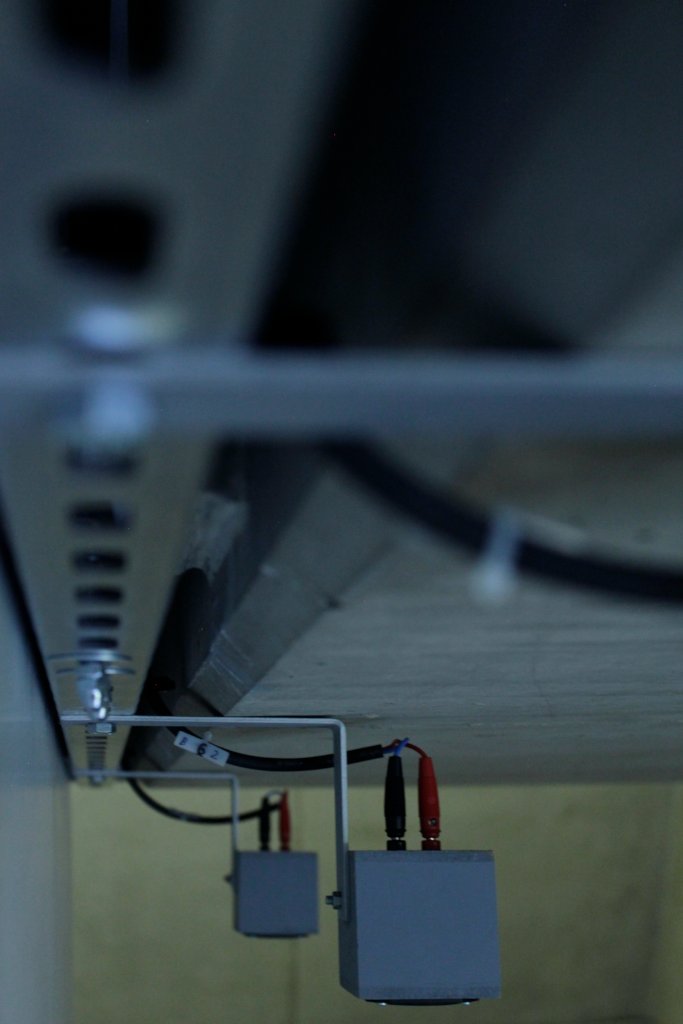Through Segments (2020)
Sound installation by Hanns Holger Rutz, Daniele Pozzi, David Pirrò, Ji Youn Kang. 32 speakers and 4 microphones, in the staircase of the Iron House of the Graz Art Museum (Kunsthaus). Curator: Katrin Bucher Trantow.
The four artists listen into the storeys of the Iron House’s staircase using real-time computer algorithms, taking an acoustical image of the visitors’ movements, forming four individual reactions. It is a poetic attempt to think about the distributed, the fragmented, the parallel. During the development phase, the artists worked independently, but at the same time they observed and interrogated each other, performing the gesture of a “simultaneous arrival” (Sara Ahmed). They enacted a human algorithm, informed by reiteration and duplication but never being identical. The aim is not one “of all converging towards the same, but circulating, making common relaying, relaying back, being relayed” (Isabelle Stengers).




Through Segments
Early on, we explored the surplus or excess of algorithmic agency, manifesting itself as an indviduation and differentiation in the process of experimentation and implementation, by departing from the “same” initial configuration or “(basic) algorithm”. To depart from the same, and come to four aligned, coherent, similar but individual systems or machines, which then begin to grow and refine the compositional process. But we found that each algorithmic disposition produced a kind of territory closer to one of the artists, whereas it remained “invalid” for other artists. How could we achieve a balance? I entered the figure of “parallel writing” or “simultaneous writing”, a new disposition that would solve the problem by inverting the arrows; instead of departing from a common algorithm, we needed to ensure that we could work independently without hierarchy, next to each other, but with a form of exchange and communication that permitted us to arrive at a common site (site of thought, site of aesthetic objects, physical-architectural site).




I conceived my part of the piece as a set of three distinct sonic gestures rendered over time from snapshots of the microphone signal. The first looks at spectral occurrences that stand out from the common signal, emphasing and isolating them as resonant impulses. In analogy to taking the steps of the stairs, sets of impulses are sorted based on the total graph of pairwise similarities, yielding thus more or less coherent sequences of “counting” your steps. Along with the reverberation of the space, these impulses activate the space and highlight its acoustics. The second gesture takes this resonant information and spreads it out across time, producing sustained sounds that illuminate or colourise the space, travelling relatively far across the vertical dimension and mixing with the layers of the other artists. The third gesture builds over very long time by highly accelerating the microphone signal and, in opposition to the other gestures, deemphasising the resonant properties, focusing instead on the rhythmic elements. As each gesture is projected through four of the eight speakers in each storey, this last gesture unfolds an intimate and lively spatiality when listening at close distance.




All of these gestures accummulate as a memory over time. The overall installation was programmed to permutate the ordering of the four artists’ systems across the storeys (every two hours each day they would change), and each of the four computers had a dedicated harddisc for storing these gestures, therefore as the exhibition went on, distinct qualities of each storey emerged in each of my four memories.
Three types of gestures in Through Segments
Futher Reading
The extensive artistic research process is exposed through the Research Catalogue.